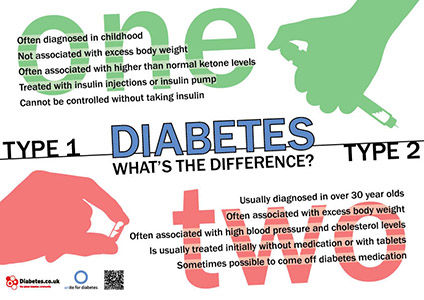Dealing with diabetes: tips to help you manage
Diabetes is a problem that’s growing fast. With childhood obesity rates growing and people’s lifestyles across the world changing dramatically, the numbers of people diagnosed with the condition has grown massively. It’s estimated that more than 3.5 million people in the UK have been diagnosed as diabetic, and there may be many more with the condition who don’t yet realise it.
For those who already have it, though, it doesn’t have to be a life-ruining illness.
June 12-18th is National Diabetes Week in the UK, which aims to raise awareness of the condition to a wider audience. This year’s theme is Setting the Record Straight, aimed at dispelling misconceptions about the condition and giving people a clearer and more accurate view of just what living with diabetes can really be like.
Learning about how to manage your condition can give you confidence and make life much easier and happier, so here’s a few important guides to making the most of life without letting diabetes get in the way. If you need a few pointers on how to get some of the products mentioned, check out the Thesis Care website.
Finding your type

(image from www.diabetes.co.uk)
It’s important to establish that diabetes is a wide-ranging condition and its symptoms will vary from person to person. Most importantly, there are two major types that account for most (but not all) people with the condition – type 1 and type 2 diabetes. Both involve issues with how the body handles insulin, the hormone created in the pancreas that is needed to break down sugars such as glucose in the blood.
Type 1 diabetics cannot produce insulin in the body, meaning glucose can’t be broken down to provide energy. They have to rely on daily doses of insulin, via injection or an insulin pump, although a good diet and exercise can help reduce the problems too. This requires keeping equipment around whenever possible, so an insulin wallet or case to store needles is an important product to have.
Type 2 diabetics, meanwhile, have cells which can produce insulin that is inadequate – either less than the body needs, or because it does not work effectively. This is mostly treated with medication, although glucose injections may also be needed to boost the body’s supply.
The main symptoms of diabetes include feeling very thirsty, urinating more frequently than usual (particularly at night), feeling very tired, weight loss and loss of muscle bulk, cuts or wounds that heal slowly and blurred vision.
Type 2 diabetes is by far the more common type, accounting for around 90% of the 285 million people worldwide with condition. Since it mostly tends to appear to people once they have reached the age of 40, it can be tough for some to adjust their regular habits to help limit its effects on the body.
Juvenile diabetes affects around 22,000 children in the UK, with the vast majority of them suffering type 1 diabetes. However, type 2 is becoming more prevalent as a consequence of factors such as childhood obesity, lack of exercise or other factors that lead to insulin resistance.
Best foot forward
For a diabetic, the feet can often be a major problem area due to the effects that raised blood sugar has on circulation – major blood vessels can be ‘furred up’, and this in turn leads to reduced sensation and heightens the risk of injuries.
Another common diabetic symptom is neuropathy, or nerve damage. Without any signals coming from the nerves in the feet, it can be harder to tell when blisters or minor burns occur, problems that could lead to infection, bone fractures and ulcers – and even worse.
Caring for your feet becomes a vital part of your life, so checking your feet daily is a good way to stay on top of any problems and can be done by incorporating it into your morning routine.
Specialist products such as ProSox can protect the feet without adding any extra pressure that might prove harmful in the long run, while foot creams with antibacterial ingredients can reduce the risk of developing infections and athlete’s foot. Also, our LimbO protectors can stop leg ulcers from getting wet, reducing the risk of infection and helping keep feet well-protected and safe.
Eating right

(image from Diabetes UK)
It’s a common assumption that those with diabetes have to avoid sugar almost entirely or rely on specific ‘diabetic-friendly’ foods – the reality is that those with diabetes can enjoy a wide range of foods, including many with sugar, as long as they maintain a balanced diet. Indeed, some diabetic foods can still affect your blood glucose levels, reducing the benefits they have over standard, ’non-diabetic’ products.
A drop in blood sugar levels throughout the day could lead to hypoglycaemia – which in its most serious cases can lead to seizures and comas. While these are rare, mild hypoglycaemia can still cause shaking, dizziness and fainting. In these situations, it’s important to keep an emergency source of energy around – such as those featured in the Hypowallet – to boost those levels and keep you fit and active all day.
Putting together a targeted eating plan with a dietician can help you identify any problem foods that should be avoided, and sort out a schedule for eating that gives you the confidence to eat what you like, without diabetes deciding your eating habits.
With our range of products to help with all kinds of conditions, Thesis Technology Products can give you the support and guidance you need. Our range of diabetic aids can be found on our Thesis Care website at www.thesiscare.co.uk.
To find out more information about National Diabetes Week, visit www.diabetes.org.uk.
Help us get Lindsey Gates home
(picture via GoFundMe) LimbO needs your help to help fly a terminally ill mother home from America, so she can spend her last few weeks with her family ...
Written by LimbO Products

